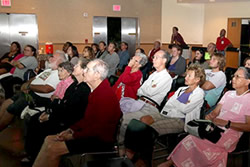10 Years of Ocean Protection: Stories & Photos
The Fascinating History of Shipwrecks and Maritime Archeology in Papahānaumokuākea
 Tracing the history of natural science research in the Northwestern Hawaiian Islands (NWHI) is one part of the maritime heritage presentations given by Papahānaumokuākea Marine National Monument maritime archeologist Dr. Kelly Gleason. Most recently Dr. Gleason spoke at the Thursday Night Education Lecture Series at Hanauma Bay in recognition of the 10th Anniversary of the Northwestern Hawaiian Islands Coral Reef Ecosystem Reserve. She explains that Hawaiian royalty initiated expeditions to the NWHI throughout the 1800s and scientific inquiry began as early as 1902 and continues as a collaborative effort today. Shipwrecked sailors actually made the first maritime heritage observations by drawing detailed maps and making log book and journal entries. Surveys of these documents and archives, continues to assist modern researchers in their quest to identify artifacts from sunken ships.
Tracing the history of natural science research in the Northwestern Hawaiian Islands (NWHI) is one part of the maritime heritage presentations given by Papahānaumokuākea Marine National Monument maritime archeologist Dr. Kelly Gleason. Most recently Dr. Gleason spoke at the Thursday Night Education Lecture Series at Hanauma Bay in recognition of the 10th Anniversary of the Northwestern Hawaiian Islands Coral Reef Ecosystem Reserve. She explains that Hawaiian royalty initiated expeditions to the NWHI throughout the 1800s and scientific inquiry began as early as 1902 and continues as a collaborative effort today. Shipwrecked sailors actually made the first maritime heritage observations by drawing detailed maps and making log book and journal entries. Surveys of these documents and archives, continues to assist modern researchers in their quest to identify artifacts from sunken ships.
 The 2002 NWHI Reef Monitoring and Assessment Program (RAMP) cruise initiated the first systematic survey of maritime heritage resources in the region using modern technology. Audiences have been most excited to learn about a still unidentified whaling shipwreck discovered at French Frigate Shoals in 2008 with additional artifact discoveries in 2009 and 2010. Three whaling shipwrecks were reported lost there in the 1800s and the preponderance of evidence is now pointing toward this being the Two Brothers, which was lost in 1823. It is well known for her ties to the story of the whaler Essex, which inspired the classic novel Moby Dick. Recovered artifacts are now being conserved to help in the positive identification of the whaler. Archival research to date indicates that there are at least 60 known ship losses in Papahānaumokuākea, the earliest dating to 1818. So far 17 have been discovered and documented at least in a preliminary fashion.
The 2002 NWHI Reef Monitoring and Assessment Program (RAMP) cruise initiated the first systematic survey of maritime heritage resources in the region using modern technology. Audiences have been most excited to learn about a still unidentified whaling shipwreck discovered at French Frigate Shoals in 2008 with additional artifact discoveries in 2009 and 2010. Three whaling shipwrecks were reported lost there in the 1800s and the preponderance of evidence is now pointing toward this being the Two Brothers, which was lost in 1823. It is well known for her ties to the story of the whaler Essex, which inspired the classic novel Moby Dick. Recovered artifacts are now being conserved to help in the positive identification of the whaler. Archival research to date indicates that there are at least 60 known ship losses in Papahānaumokuākea, the earliest dating to 1818. So far 17 have been discovered and documented at least in a preliminary fashion.
